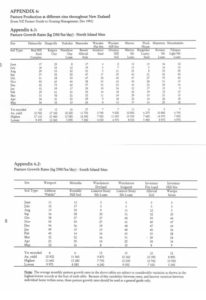This time of the year, when it is cold, wet and the days are short, is a good time to look at the paddocks and decide on stocking levels for the coming year. It is so easy to see the abundant grass in Spring or Autumn and add more stock or do more matings than the land can support later.
The old method of calculating the feed required is to use Livestock Units (LSU) or Ewe Equivalents (EE) This gives a standard against which other classes of stock can be compared.
1 LSU unit is a 40kg ewe suckling a lamb, the assumption is that she will require 10kg of dry matter per week. The carrying capacity of the land is how many LSU can be supported over winter.
Because of their efficient digestion system an adult llama is rated as 1.8 stock units. But a female in late pregnancy or early lactation can need twice as much feed.
If the land is over stocked we can provide supplementary feed, but unless a rigorous manure collection plan is in place, the stock will be forced to graze closer to their middens than is ideal, causing an uptake of worm eggs and the need for frequent faecal egg counts and drenching.
With sheep, the lambs and many of the older ewes are off the property by summer, but llamas are not weaned until 8-10 months of age which makes pasture management harder. We also tend to allow our llamas to come to the end of their life naturally, and as they live for around 20 years this is long commitment!
The ideal is to shut a paddock or two up for hay in Spring which will provide feed during the Winter months, but it is not always possible to cut small paddocks with modern large machinery.
Another option is to allow a paddock to go fallow. The traditional method was to rest 1 paddock every 7 years. It does not have to be locked up for the entire year, once the grass has seeded, stock can be let back in to eat the “standing hay” and trample the seed and stalks into the ground. Or you can top it and let it compost into the ground, although if you are in a Facial Eczema prone region, which is most of the North Island, and the upper South Island now, you would not allow stock to graze the cut or trampled area in warm damp conditions.
If you want to investigate feed planning further, the NZ sheep council put out a booklet on the subject in 1994. It was republished and redesigned in 2012, but the only change seems to be a section on how to use a Pasture Plate Meter. It has some very handy information on the feed values of various grasses and supplements. The tables below on pasture production in various parts of NZ came from this publication. A PDF of the booklet can be downloaded
If you want to delve deeper into pasture management, an excellent booklet called Livestock Feeding on Pasture, was published by the NZ Society of Animal Production in 1987. There are bound to be more recent publications but I like this one as it is easy for a layman to read, and goes into detail about how to manage pasture and its recovery in drought conditions which is more relevant to many of us than it used to be!

